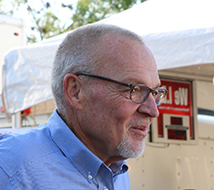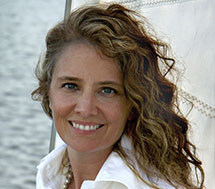the view from lake county
|
“You battle with how do you manage the growth versus seeing the dollar signs in just letting it happen?” If we would go back and do it again, I’m sure we would have done a better job of planning for it.”
|
Robert Chandler was the person who was going to leave Lake County where he grew up and never come back. But after a sojourn to North Carolina where he attended Davidson College, he married a Lake County native. Although they initially settled in Orlando, they returned to Lake four years ago when Robert accepted a job as the county’s coordinator of economic development and tourism, and in March 2015 was named the county’s first ever Director of Economic Growth. Robert has never regretted the decision to return to his roots.
Today, he says, Lake County is trying to take a more nuanced, strategic approach to economic growth than it did in the pre-recession boom years, when property values skyrocketed along with population growth, but little attempt was made to diversify the economy away from its heavy dependence on the construction and real estate sector. In hindsight, says Robert, Lake County might have managed things differently. “You battle with how do you manage the growth versus seeing the dollar signs in just letting it happen?” he says. “If we would go back and do it again, I’m sure we would have done a better job of planning for it.” Robert is leading efforts to diversify the Lake County economy in ways that capitalize on, but also support, its existing natural, geographic, and human assets. For example, because the county is located in the middle of the state, an hour and a half from two ports and with access to an interstate highway, it is well situated as a distribution and warehousing center. Lake County also provides fertile ground for the expansion of its health-care-services sector, given its median age of 45 (versus 35 in neighboring Orange County). Seven percent of the county’s residential workforce is employed in the manufacturing sector (versus four percent statewide). However, many now have to commute out of the county to secure employment. Creating a more robust manufacturing base in the county will not only add dimension to the economy but will allow residents to work closer to home and to participate more actively in civic life.
|
“It is critical we not just focus on the types of businesses coming in but also their likely impacts.”
|
“It is critical we not just focus on the types of businesses coming in but also their likely impacts,” Robert also reports. “So industries that do not fit the mold of what we are looking for—to balance out our need to grow jobs with our need to protect our environmental, natural resources, and ecotourism assets—are not those we will pursue. For example, when we talk about attracting manufacturing we are talking about clean advanced manufacturing that has minimal impacts.”
Workforce education is another part of the economic growth strategy Robert is helping map for Lake County. That includes a Center for Advanced Manufacturing, which broke ground in October 2014. The Center is a partnership between the county and Lake Technical College in Eustis, and will train computer numerical control machinists, welders, and fabricators. |
“While we have a large percentage of our workforce in manufacturing they don’t have the higher-end manufacturing skills we need.”
|
“While we have a large percentage of our workforce in manufacturing they don’t have the higher-end manufacturing skills we need,” Robert reports. “We were hearing from our manufacturing businesses they have to go out of state to get qualified employees.” Another program—the 222 plan—is a partnership with Lake-Sumter State College and University of Central Florida allowing high school students to receive college credit for attending vocational training programs at these local colleges.
|
Although Robert maintains that the county’s comprehensive plan delineates strict open space, water usage, and buffer requirements for land use development, he also reports that “we have gotten less and less restrictive in general.” |
Because Lake County does not offer grants or other economic incentives to attract businesses, in order to win in the economic development game, “we have to make sure we have our house in order,” says Robert. “The right zoning, and the right relationship with broker networks so that if someone comes in that we want to attract, we have a place to put them.” Although Robert maintains that the county’s comprehensive plan delineates strict open space, water usage, and buffer requirements for land use development, he also reports that “we have gotten less and less restrictive in general” as there has been a shift in attitude toward growth over the last ten years, a pendulum swing that began in the recession years.
The debates over the Wellness Way Sector plan illustrate the challenges the county faces as it looks for new ways to diversify the economy. The plan covers 16,200 acres of property in Clermont, in South Lake County. It requires that for every house built 1.5 jobs must be generated through commercial development—450 square feet of commercial space must be created per employee. Currently, over 90% of the land is zoned for agriculture or other rural use. That would change if the plan is approved. |
Orlando Sentinel reporter and columnist Lauren Ritchie maintains that the Wellness Way plan has no “detailed information about protecting water resources, considering it encompasses … the highest recharge area of the Florida Aquifer, the source of much of the state's drinking water.” |
Opponents say the devil is in the plan’s details, or lack thereof. In a recent article, veteran Orlando Sentinel reporter and columnist Lauren Ritchie maintains that the Wellness Way plan has no “detailed information about protecting water resources, considering it encompasses … the highest recharge area of the Florida Aquifer, the source of much of the state's drinking water.” According to Ritchie, if the plan goes forward, “residents can count on seeing other home developers use the same scheme to blanket Lake in subdivisions and overcrowd its schools.” Others are troubled that the residential development will likely precede the commercial, regardless of the plan’s zoning requirements.
Robert takes another view. “It is a classic case of everyone won’t get what he or she wants,” he says. “The plan is created to help generate jobs and help diversify the economy. There are those who don’t want any new housing built as part of that plan, just commerce centers, but in reality that is not how things work. You can’t just build commerce without housing—people need places to live close by to work, and logistically, landowners may not have demand for all that commercial upfront. So if we solely did a plan with no residential attached there would be no plan. You would end up with piecemeal growth with bad residential and little commercial.” Robert maintains that the land that is originally zoned commercial will remain so until developed as such and will get taxed immediately as commercial land. “For us the plan is superior to the status quo, would result in a better outcome than had we done nothing on every variable—environmentally, in terms of job generation, restrictions on the amount of residential development, and the impact on Clermont,” he says. |
“For us the Wellness Way plan is superior to the status quo, would result in a better outcome than had we done nothing on every variable—environmentally, in terms of job generation, restrictions on the amount of residential development, and the impact on Clermont,” Robert assets. |
Robert will likely face continuing challenges as director of growth in a county at a critical crossroads in its development history and diverse, often conflicting, interests competing for influence over its future. “The things that make Lake County a special place to live— whether it is its natural resources or its small town character—can be at odds with unplanned growth,” Robert admits. “This is my home, so every decision I make is meaningful to me.”
|
more on the view from lake county
Lake County Commissioner Welton Cadwell Reflects on an Economy in Transition
To begin our Lake County “story of place” we speak with Welton Cadwell, a 23-year veteran of the Lake County Board of Commissioners. Today, as Florida’s real estate market reheats and memories of a pre-recession era of unchecked development remain fresh, thoughtful Lake County community leaders like Cadwell are hoping to chart a balanced, managed growth course for the county that ensures that it adapts to systemic challenges in a way that secures its long-term health and well-being.
READ MORE |
An Organic Farmer Tells His Cautionary Tale
Hugh Kent, owner of King Grove Organic Farm, says that he is deeply troubled by changes in the political and economic landscape in Lake County and Central Florida that are reversing the innovative land-use codes that so many local advocates worked so hard to put in place. “We were able to do some really good things with zoning before the recession,” he reports. “But at the beginning of the economic downturn, when people stopped hearing backup signals on earth moving equipment, they just forgot about what the rampant development was doing to the land around here."
|
US Green Chamber CEO Michelle Thatcher Crafts a Careful Outreach Strategy
Michelle Thatcher, CE0 and co-founder of the over 1000 member U.S. Green Chamber of Commerce grew up in one of the “greenest” communities in Washington State. Now based in the very different social and political climate of Central Florida, she has crafted an outreach program for the Green Chamber that is carefully tailored to a business community that may not always be initially receptive to its message.
READ MORE |





